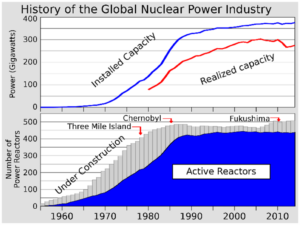Our Industry
Nuclear Events & Where the Industry is Today
August 10, 2023
“Nothing in life is to be feared, it is only to be understood. Now is the time to understand more, so that we may fear less.” – Marie Curie (Nobel Prize recipient in Physics for her pioneering research into “radioactivity”)
In my previous blog post, I wrote about how we must continue developing sustainable energy sources as our demand for power increases. While hydro, solar, and wind projects are leading the way as sustainable sources of power, these technologies will not provide enough capacity to meet our growing power demand and reduce our dependence on fossil fuels.
When people think about nuclear energy, they often remember the accidents associated with nuclear power plants. In a separate white paper, linked here, we provide an in-depth history of nuclear power, and specifically reference three large nuclear accidents in Harrisburg, PA, at the Chernobyl Nuclear Power Plant, and in Fukushima, Japan. What is the impact of these events today and where the industry is now?
IMPACTS OF ACCIDENTS ON THE INDUSTRY
The Three Mile Island accident in Harrisburg, PA, in 1979 was a significant turning point worldwide in the development of commercial nuclear power. With two exceptions, the number of new reactors worldwide increased yearly from 1963 through 1979. While the event did not lead to a collapse of the industry in the US, it stopped the historic growth.
The oil crisis of the 1970s and evaluations indicating potential overcapacity in the available baseload of the system had already resulted in the cancellation of 40 planned nuclear facilities in the US. After the Three Mile Island accident, the number of reactors in construction in the US declined from 1980 through 1998. At the time of the accident, 129 new nuclear reactors were approved for construction, but only 53 were built.
Based on the accident investigation, the federal requirements to correct safety issues and design deficiencies became more stringent, significantly increasing the length of the review process. During this new review process, further complicated by the Chernobyl accident seven years later and increasing local opposition, construction schedules and cost increased significantly.
Ultimately, no new nuclear plants would be approved for construction in the US until 2012, when the Nuclear Regulatory Commission (NRC) voted to approve Southern Company’s application to build and operate two new reactors at its Vogtle facility in Georgia.
While the increase in the US halted after the Three Mile Island incident, the global construction of nuclear plants was similarly impacted after Chernobyl, see Figure 1.

Figure 1 – Global History of Nuclear Power
Then and now. By 1992, 110 nuclear reactors in the US produced nearly 22% of all electricity used in the country. As of July 2023, 92 active reactors in the US produce 18.9% of electricity.
RESURGENCE OF AN INDUSTRY
After decades of decline and stall, we are see signs of a resurgence of nuclear power as a viable option for our future needs. Recent events such as the COVID-19 pandemic and the Russian invasion of Ukraine have raised awareness of global energy shortages and the urgency to end our dependence on fossil fuels.
For example, France had initiated a plan to reduce its dependence on nuclear power during President Macron’s first term but now plans to build six new reactors and a dozen more Small Modular Reactors (SMR).
The United Kingdom is also moving full speed ahead on eight new reactors and 16 SMRs. To add to the list, Japan has also decided to restart many of its reactors that had been shuttered since the accident at Fukushima. Germany, which has been one of the most resistant to nuclear power, has decided to extend the life of its three nuclear reactors. In the US, as mentioned earlier, two new reactors approved in 2012 are due to come online in 2023 in Georgia. In addition, the US has approved NuScale’s SMR design.
Wind and solar energy alone will never be sufficient to eliminate fossil fuel dependence in the creation of electricity. Even the world’s most technically advanced and wealthiest countries have not been able to exceed more than about one-third of their electricity from wind and solar sources. In the US, approximately 12% of the electricity is provided via wind and solar. Denmark, considered a leader in green power, generates about 50% of its electricity from wind. Their grid is fully integrated into the Scandinavian grid, including Sweden, Norway, and Finland, which is dominated by hydroelectric power and nuclear energy. Denmark’s vaunted wind power generation only accounts for about 4% if the total annual electricity generation of the Scandinavian grid.
In the next blog of this series, we’ll shift towards looking to the future and share why nuclear energy is the key to sustainability.
7×24 CONFERENCE
On a related note, I will also be speaking more in-depth on the topic of nuclear energy at the 7×24 Fall Conference in Grapevine, TX. For more information or a link to register, please visit their website here.











